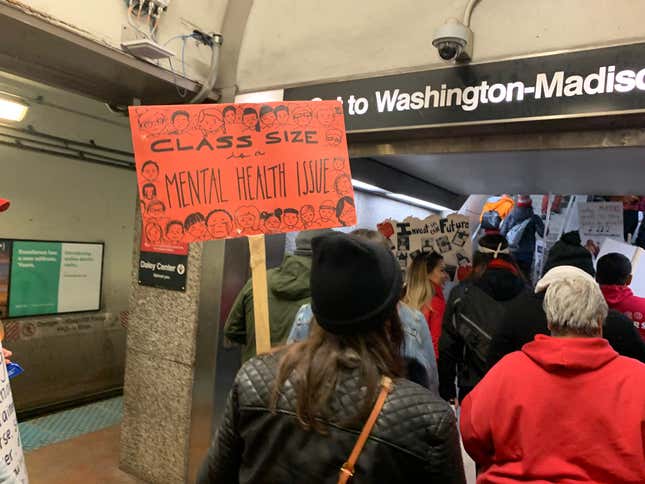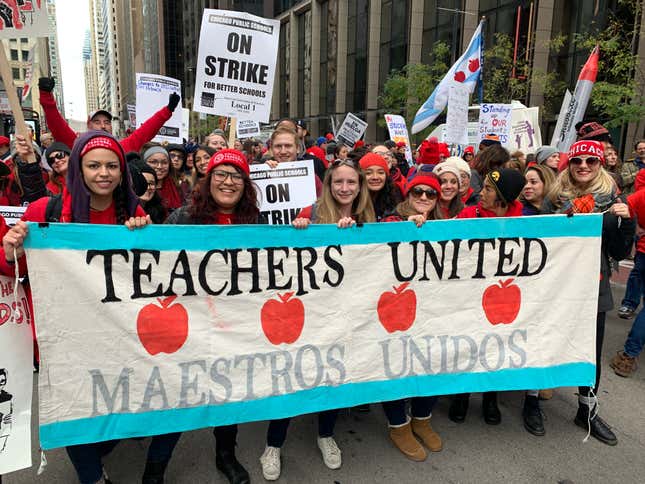'We’re Setting Up Our Kids for Failure': Carrying the Banner With Chicago Teachers
Latest
Image: AP
CHICAGO — The fabric of this city stretches down the picket line. It threads itself through community centers in century-old buildings, through union halls and churches and restaurants and apartments where protest signs get painted on living room floors. All of these threads converge in the streets as the Chicago teachers strike stretches into its second week, where frustrated, exhausted teachers will pick up their mother’s banners and yell until their voices are hoarse.
At a community center on the north side of the city last week, two dozen teachers, students, and organizers sat around a table to take a break after picketing and before going downtown for a rally outside the Board of Education. At the back of the room, a table was laden with trays of tacos donated by the carnicería across the street, along with rice, pita, hummus, and pastries donated from a nearby Mediterranean restaurant. A pizza got delivered. Someone else brought in a carafe of coffee.
Cindy Zucker, a retired Chicago Public School (CPS) teacher and administrator, was at the center to support the striking teachers and students. She said that for many teachers, the 2012 strike was “a radicalizing moment.” One year after that strike, the school where Zucker taught became one of the 49 elementary schools that the city’s Board of Education shut down. The building, which welcomed its first students in 1909, now houses a private Waldorf School.
Oh, we’re furious. They’re taking from the most vulnerable students.
“It’s almost like a self-fulfilling prophecy,” Zucker told Jezebel. “You close the schools, so you don’t have a center for your community, and your kids don’t have a safe place to go that they trust, and then people move out.”
Students can also recognize that cycle: Riley Lamarre, a senior at Northside College Preparatory High School, had dyed her hair neon red in support of the strike. “I like standing out there with the teachers because a lot of the stuff that they’re on strike for benefits us, so it feels like the least I can do,” she said.

The demands of the union’s 25,000 members aren’t exactly radical. They want smaller class sizes, a nurse in every school, more school librarians, social workers, and case managers for students who need what’s called an Individualized Education Plan. They want to keep the limited prep time they have. Apart from the strike, many Chicagoans want an elected school board whose members are not hand-picked by the mayor.
All of these asks undercut the narrative—pushed by CPS and the mayor’s office—that the teachers are on strike to give themselves more money. What becomes clear after any time spent on the picket is that the stories you hear are about the conditions inside Chicago public schools, but they’re also about housing, gentrification, health care, food, immigration, transportation. They are stories about cyclical problems faced by generations in the city, and how communities works to stitch together their own safety nets in the face of systemic neglect. Ultimately, they are stories about the future of the city and how to fight for it.
At the picket line outside of Avondale-Logandale Elementary School, which serves more than 600 students from preschool through eighth grade, the first sight is a welcome one: a folding table covered with donuts, bananas, carafes of coffee, a box of toe warmers, and two giant containers of M&Ms. It was one of many reminders that week that teachers are on a god tier when it comes to having emergency snacks on their person at all times.
-

-

-

-

-

-

-

-

-

-

-

-

-

-

-

-

-

-

-

-

-

-

-

-

-

-

-

-

-

-

-

-

-

-

-

-

-

-

-

-










































